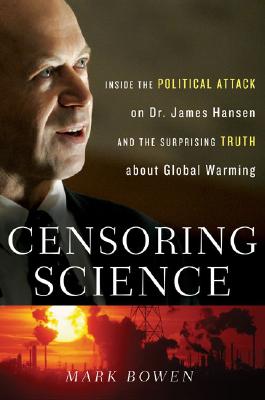

| CENSORING SCIENCE Inside the Political Attack on Dr. James Hansen and the Truth of Global Warming Mark Bowen New York: Dutton, December 2007 |
Rating: 5.0 High |
|||
| ISBN-13 978-0-525-95014-1 | ||||
| ISBN-10 0-525-95014-1 | 324pp. | HC/GSI | $25.95 | |
This is the tale of one scientist and his battle against political suppression of important truths he discovered. The scientist is Dr. James Hansen of NASA's Goddard Institute of Space Sciences (GISS). Dr. Hansen is a climate researcher who in the course of his long career has earned a position at the top of his field. Many of his colleagues say his comprehensive grasp of the total picture of climate change is unequaled.
In addition to wrestling with the formidable problem of understanding Earth's climate, Hansen has had to contend with the political machinations of the Bush administration. Whether driven by ideology or political expediency, administration officials routinely strove to cover up or diminish facts they found inconvenient. The fact of global warming was only one of many to receive this treatment; it is exceptional only because it was deemed more troublesome than most.
The administration of George W. Bush is not the only one to have conducted such suppression and distortion. But it has pursued those practices to an unprecedented degree, both in breadth of subjects affected and in intensity. This has been covered elsewhere, and I won't rehash the evidence here. I want to focus on the battles at NASA and NOAA, the federal government agencies principally responsible for climatology research. Bowen's book documents these battles in depth. On the pages linked below I provide a few fragments from his account.
It may be in the genes. It may come from upbringing or education. But however it arises, the mark of a scientist is an unquenchable desire to find out how the world works. We are indeed fortunate that so many do acquire this drive to understand; for we owe to it most of the underpinnings of modern life, and success usually requires intense effort over a long period of time. And, as we learn in this book, it can also require overcoming formidable opposition.
James Hansen clearly has the scientific soul. The proof is not that he speaks out against Bush administration distortion of the facts about global warming; or rather, that is only a minor facet of the proof. The major one is that Hansen has devoted so much effort to learning about the subject, in the standard scientific way of quietly gathering data and writing papers only other scientists read. It is rare for a scientist to be a celebrity, so much so that most scientists doubt the competence of one who is, like the late Carl Sagan. But when a scientist has uncovered an important truth, and that truth is being suppressed, he cannot help but speak out. Hansen has the spirit to do so. I am very grateful.
These attempts to "stay on message" were carried out by public affairs officials at the two agencies. They were mostly political appointees. In furtherance of this aim, the officials would
Bowen has done a very competent job of researching and organizing the material in this book. He presents it in an informal style that makes the book easy to read and hard to put down. Errors, grammatical and factual, are few. I noted two major defects: the profusion of names made it hard to keep track of the players; and the paucity of dates meant I often had to page back and forth to find out when an event took place. (Rather than providing an explicit calendar date, Bowen is given to saying things like "A week after Hansen's Iowa speech, Mahone called Gretchen into his office...") I feel the addition of a timeline of Dr. Hansen's public presentations would go a long way toward enabling readers to better understand the chronology of events.
In addition to covering the political battles, Bowen does a great job of describing Hansen's career and the scientific discoveries he and others made in that period. He does this mostly in Chapters 8 and 9. If you read no other part of the book, read those two chapters; they are as clear an explanation of the complexities of climate change as I've seen.
The index is not quite accurate, not quite complete. The names omitted include Monica Goodling, Crystal Jezierski, and Jane Cherry (all on p. 135) — as well as Benjamin Franklin (p. 75). It's true that these first three do not figure directly into the story of climate-science suppression. But I would argue that if they are worth mentioning in the text, they should be indexed. As for Ben Franklin, he is credited with the first discussion of the parasol effect. I think this makes him relevant to climate science.

 To contact Chris Winter, send email to this address.
To contact Chris Winter, send email to this address.